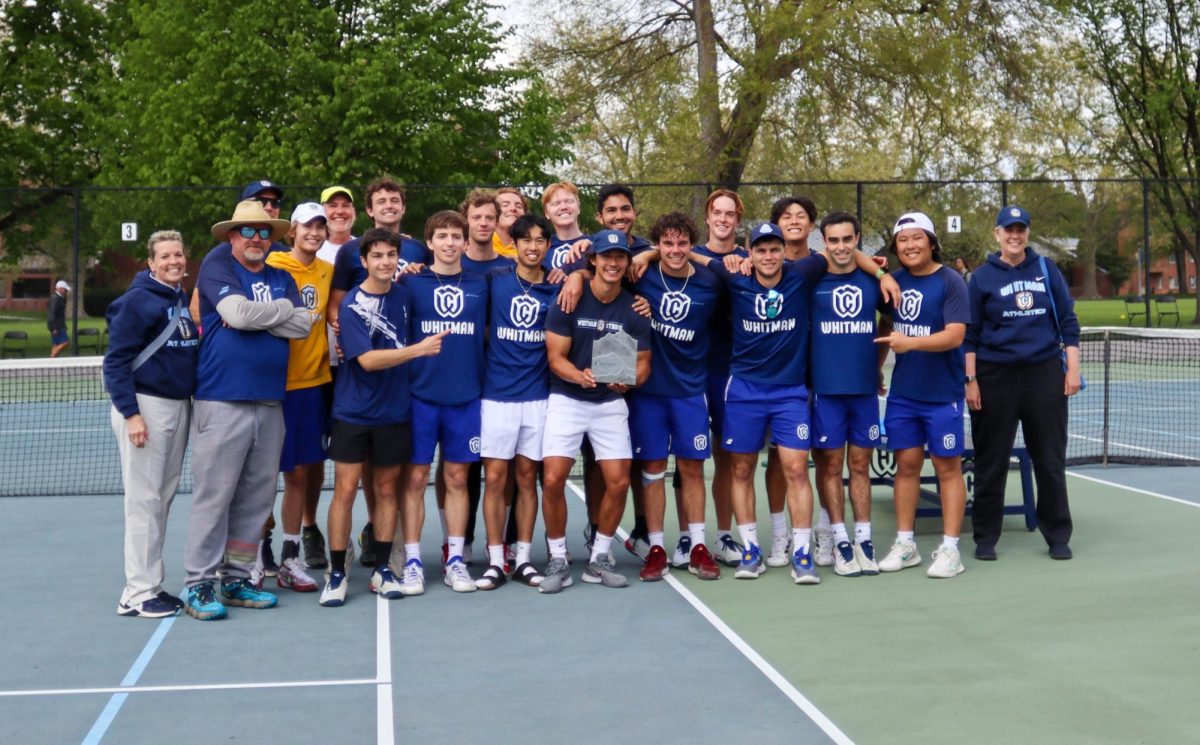
Dozens of students’ blue shirts filled the rows of Maxey Auditorium reading “save the ski team,” but the focus of Monday night’s ski team forum was the administration’s presentation of their plan to convert alpine and nordic ski teams from varsity to club sports.
The forum, a follow-up event to the first on March 11, came three weeks after President George Bridges’ March 10 announcement of the decision. The Monday gathering offered a continued opportunity for student and community discourse on the controversial decision, as well as an opportunity for Bridges, Treasurer Peter Harvey, Athletic Director Dean Snider and Provost and Dean of Faculty Lori Bettison-Varga to detail the plan under which both ski teams would move from NCAA Division I competition through the Rocky Mountain Intercollegiate Ski Association to the club-level United States Ski and Snowboard Association.
A group of skiers, parents and alumni have drafted a counter-proposal that would keep both teams as varsity sports for more money than the administration’s proposal, but still half of this year’s budget. Both sides hope to discuss the counter-proposal at a smaller meeting between Bridges, Snider, Bettison-Varga and representatives from each ski team as well as a couple of ski team parents and both coaches. The originally planned April 10 meeting, where the Board of Trustees was expected to make a final decision on the administration’s proposal, has been postponed.
Under the administration’s plan for the proposed club teams, $40,000 would be committed per year over the next three years for men’s and women’s alpine and nordic teams. The $40,000 club budget, which represents a savings for the college of $200,000 yearly with the lay-off of Nordic coach Calisa Schouweiler and Alpine coach Tom Olson, would still make skiing the school’s most expensive club sport. By comparison, club cycling (men and women) has a price tag of $19,000 per year and the most expensive varsity sport, baseball, costs $44,075.
The $40,000 yearly is not guaranteed after the three-year window, which would see current ski team first-years through the end of their Whitman ski career. The ski program would also have to fundraise $13,970 yearly to meet the $53,970 estimated cost of club-level competition.
The ski teams, however, remain hopeful of returning to NCAA competition next year. On Sat., April 4, the 59-page counter-proposal was sent to Bridges. Entitled “Working Collaboratively for the Collective Good” (a quote from George Bridges’ Feb. 19 Message to the Whitman Community), the document begins with a description of Whitman ski history and concludes by recommending that all ski teams remain varsity programs.
The proposal itself calls for $120,000 of Whitman funding made up of $10,000 yearly ski team endowment, $30,000 from the original ski team budget, $40,000 that would be used to augment other athletic programs if the administration’s plan passes and $40,000 of other funds. Coupled with $62,000 in fund-raising, parent and student contributions, this money would be sufficient for a retooled, cheaper varsity program according to the proposal’s creators. The proposal also argues that cutting the varsity ski team will hurt campus diversity, national prestige and alumni giving while criticizing the administration for failing to request input from the teams or their supporters.
“No parents, students, alumni, or friends, all of whom are Members of the Whitman Community, were asked for input or assistance before the decision to convert ski racing…Members of the Whitman Community were not provided the opportunity, in President Bridges’ words, to ‘work collaboratively for the collective good,'” the proposal states.
The savings the club system will generate, however, look increasingly necessary to the administration as economic uncertainty for the college increases.
“We may have to do additional cuts in the future. We are not sure what will happen this fiscal year,” Harvey said at the forum.
Alongside the ski team, Harvey and Bettison-Varga cited numerous college-wide cuts including the indefinite deferral of five tenure-track teaching positions, a $20,000 decrease in library and athletics budgets, and across-the-board five percent cuts.
First-year Nathan Ord, a member of the men’s alpine team, understands the economic realities for the college. He sees weaknesses in both the club format and the joint proposal.
“With the parents’ proposal, the main flaw is that it still costs the school too much money. In Bridges’ plan, the flaw is that it provides too little money,” Ord said.
While ski team members saw value in the public forum, most believe the real work will be done in the smaller meetings which dates have yet to be set.
“I don’t think [the forum] is a scenario conducive to what needs to get done. I think we need to meet and find a place in the middle,” said first-year Lexie Drechsel, an alpine skier. “We will also have a chance for Tom [Olson] to give his input. We need a smaller meeting with the coaches input because it is crucial to have their expertise in managing the ski team.”
According to Drechsel, the proposal was created entirely by students, parents and alumni, while alpine coach Tom Olson has yet to see it, but will be on hand during the upcoming meeting with Bridges. Two parents will likely round out the ski teams’ representation at the meeting.
Since the March 10 announcement, parents and alumni have shown a large degree of support for their students and the team. The April 4 proposal was finally assembled by Chris Bromley, an alumnus, and includes letters and e-mail from eight other alumni and parent supporters of the team.
“All the parents have put in a lot of work on this, especially Brian Avery, Tyler Avery’s dad,” said sophomore Paige Devlin, a Nordic skier.
For now, the ski teams can only look hopefully toward their next meeting with Bridges and other officials : and like Drechsel, try to remain positive.
“We all still want to maintain the varsity status. Right now I am faithful and I am still trying to work really hard,” she said.



